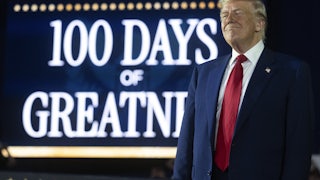The foolishness of California’s recall system—which failed this week to replace California Governor Gavin Newsom with a right-wing talk radio blowhard—is not a new story. It ought to have been made evident by the California election in 1910 that led to its creation.
The Progressive Republican candidate for governor that year, a San Francisco prosecutor named Hiram Johnson, ran on the promise to “kick the Southern Pacific out of politics in California.” He succeeded almost before Election Day. The Southern Pacific Railroad had for three decades maintained a stranglehold over California agriculture and politics, as documented vividly in Frank Norris’s 1901 novel, The Octopus. But that stranglehold was dwindling fast, thanks to Progressive reforms like the establishment of the direct primary. Johnson’s Democratic opponent, a Woodrow Wilson Progressive named Theodore Bell, was no less opposed to Southern Pacific than Johnson, but Johnson won, according to California historian Kevin Starr, through superior “showmanship and energy.”
Johnson’s election was the Octopus’s political death knell. It ought logically to have been a moment to revel in representative democracy’s cleansing victory over corrupt private interests. Instead, Johnson proposed cleansing California government still further by inviting California voters to recall any elected official who displeased them—including himself.
Affirming, in his inaugural address, a “deep-rooted belief … not only in the right of the people to govern, but in the ability of the people to govern,” Johnson called on the state to create mechanisms for recall, initiatives, and referenda. (An initiative entails a popular vote to enact proposed legislation; a referendum, to repeal or ratify existing legislation.) The state legislature wrote these into California’s Constitution the following year, and the voters ratified them by plebiscite.
A century later, Johnson’s enthusiastic embrace of the recall in particular has created a monster. Nineteen states today have procedures to recall public officials, but no state makes it so absurdly easy as California.
To initiate a vote to recall a California governor, you need to collect signatures equal to 12 percent of all votes cast in the last gubernatorial election. That’s a lower threshold than in any other state except Montana, where it’s 10 percent. Most states set the threshold more than twice as high, at 25 percent. Among the states that allow recalls, nearly half require, quite reasonably, that there be some specific grounds for removal, such as criminality, malfeasance, or physical or mental unfitness. Not California. In California, you can recall an elected official just because you don’t like his politics.
The results have been what you’d expect. Of the five instances in U.S. history when a gubernatorial recall qualified for the ballot, two were in California. These were the successful recall of Governor Gray Davis, who was replaced by Arnold Schwarzenegger in 2003, and this past week’s unsuccessful recall of Newsom. The other three were a successful bid to recall North Dakota’s Lynn J. Frazier in 1921; an unsuccessful bid to recall Wisconsin Governor Scott Walker in 2012; and a bid to recall Arizona Governor Evan Mecham in 1988 that never came to a vote because the state legislature impeached and convicted Mecham first.
It’s worth noting that three of these five recall episodes took place in our still-young hyperpartisan century. Only one—Mecham’s—involved alleged illegalities; Mecham had been indicted for perjury and fraud (though later he was acquitted). Frazier, the outlier, was a Progressive Republican who got crosswise with North Dakota voters over falling farm prices. That humiliation didn’t prevent him from later serving three terms in the U.S. Senate.
A similar pattern holds for the recall of state legislators. There have been 29 such recall elections in U.S. history; California has had the most (nine), of which five were successful. The first target, State Senator Marshall Black, was removed by voters in 1913 after being convicted of embezzlement. The most recent target, State Senator Josh Newman, was removed by voters in 2018 for the crime of voting to increase the gas tax by 12 cents. Newman was voted back in two years later.
Governor Johnson’s fetishization of initiatives and referenda also created a mess.
Today, 23 states allow voters to bypass state legislatures through these methods. They are much easier to defend than recalls. Initiatives are, for instance, a handy way to raise the minimum wage. Since 1996, minimum wage increases have appeared on state ballots 27 times, prevailing in every instance but two. (Montana and Missouri voted no, way back in 1996.)
But you can have too much of a good thing, and California does, because its signature requirements for initiatives and referenda are, like those for recalls, too lenient. California’s signature requirement is 5 percent of all votes cast in the last gubernatorial election. Only Massachusetts, Maryland, and Washington state set lower thresholds, at 3, 3, and 4 percent. More typically in other states the signature threshold is 8 to 10 percent.
Johnson’s goal in embracing direct democracy was to “eliminate every private interest from the government and to make the public service of the state responsive to the people.” But private interests aren’t so easily discouraged. California’s initiative and referendum system merely gave business a new theater in which to operate.
Almost immediately, the collection of signatures to qualify an initiative or referendum for the ballot became a lucrative business. California’s greatest chronicler, Carey McWilliams, reported in his 1949 book, California: The Great Exception, that the San Francisco firm Robinson & Company qualified 98 percent of all California initiative proposals during the three decades following World War I. Its fee for getting an initiative proposal onto the ballot was $75,000, or $866,000 in 2021 dollars. “We are the only firm of our kind in the country,” Joseph Robinson boasted. Today, of course, paid signature-gathering is the norm throughout the country.
A new California business model was also created to get an initiative passed. That was the domain of a former newspaperman named Clem Whitaker, co-proprietor of a firm based in Los Angeles and San Francisco called Campaigns, Inc., whose “manipulation of public opinion,” McWilliams wrote, “is something to excite wonder and amazement.” (Himself a former California state official, McWilliams used euphemisms like “amazement” when he meant “disgust.”) More bluntly, Upton Sinclair—whom Campaigns, Inc. was instrumental in defeating when he ran for governor in 1934 on the leftist End Poverty in California platform—called Campaigns, Inc. the Lie Factory. According to Harvard historian Jill Lepore, it was “the first political-consulting firm in the history of the world.”
Business victories in votes on California initiatives and referenda became routine. In the 1920s, Pacific Gas & Electric defeated three initiatives to create a government-owned PG&E competitor. In the 1930s, Woolworth’s and Safeway hired Campaigns Inc. to push through a successful referendum repealing a tax on chain stores. By January 1939, a study by political scientists published in Public Opinion Quarterly concluded that “well-financed interest groups initiate measures more frequently than do … reform groups.” Perhaps the best example was California’s Proposition 13 in 1978, backed by a wealthy eccentric named Howard Jarvis. It crippled the state’s taxation powers for a generation.
“You think California’s recall system is dangerous?” queried Los Angeles Times columnist Nicholas Goldberg in September. “Check out the initiative process.” Goldberg invited readers to
look at what’s coming in 2022 and who stands to benefit: Tobacco companies have qualified an initiative to overturn California’s ban on flavored tobacco. Trial lawyers are almost certain to face off against doctors over medical malpractice insurance. Indian tribes hope to legalize sports betting on Indian land at casinos and racetracks.
Proposition 13 opened the floodgates. Of the 137 ballot initiatives approved by voters since 1911, Goldberg reported, more than half came after Prop 13. The 2020 election cycle, he wrote, “broke all previous California spending records for ballot measure campaigns,” with Uber, Lyft, and other businesses spending $224 million to pass a single measure, Proposition 22, to reverse the effects of a recent state law curbing the misclassification of employees as independent contractors. The measure passed, then promptly was reversed in court, as were earlier attempts to ban gay marriage and deny government benefits, including education in public schools, to undocumented immigrants.
Even conservatives have come to dislike California’s initiative system. The Hoover Institution’s Carson Bruno cited a 2008 survey, in which 84 percent of voters found the wording of ballot initiatives “often too complicated and confusing for voters to understand what happens if the initiative passes.” Even well-informed voters had difficulty absorbing the 224-page California voter guide sent out in 2016. (It’s since been slimmed down.)
“As it has turned out,” Goldberg concluded, “the rich and powerful Southern Pacific would’ve loved the initiative process.” A century on, Hiram Johnson’s idealistic experiment in direct democracy is a miserable failure. It needs to end.








